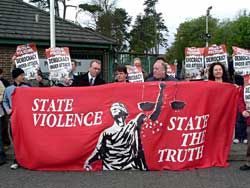4 May 2006 Edition
Collusion: Further revelations expose British terrorism

Sinn Féin picket outside PSNI headquarters at Knock, Wednesday 3 May
State sponsored murder
In a week where further revelations have been made about the involvement of British forces in the systematic murder of citizens, and as the families of those killed through this policy launch a new website, Sinn Féin's MARTIN McGUINNESS, writing for An Phoblacht says that the truth about collusion will expose the terrorism of the British state in Ireland.
Collusion has been a part of the Six County state since its creation. State forces and unionist paramilitaries traditionally shared intelligence, weapons and personnel. This weeks revelations in British State papers about the involvement of up to 15% of the UDR in unionist death squads will not surprise nationalists or republicans.
But in the 1980's the control and direction of loyalist death squads, became a key strategy of British policy in Ireland. The state, through the British Army's Force Research Unit (FRU) and the RUC Special Branch, re-armed, re-organised and re-directed unionist paramilitaries, supplying them with modern weaponry. This had an immediate and deadly impact on the number of killings in the North. Within six years of the arrival of weaponry procured in South Africa and smuggled into the six counties by British agents, loyalist murder gangs had increased their capacity to kill by 300%.
State identified targets for murder
Through a network of agents, like Brian Nelson, the British state identified targets, supplied intelligence and provided back up to the killers. The FRU had the authority to ensure loyalist assassins had a clear run to and from their target. The Special Branch ensured investigations of killings were cursory and did not result in the prosecution of the killers. The state established an effective murder machine enabling it to commission killings of citizens within its own jurisdiction. It justified collusion to itself by promoting the notion that they were 'taking the war to the IRA'. In fact once the machinery of murder was up and running no one was safe.
They killed politicians, civil rights activists, election workers, human rights lawyers and Catholic civilians. They killed to cover agents' tracks, they killed agents who outlived their usefulness and loyalists who knew too much. They sacrificed British soldiers and RUC members to retain their agents' cover.
But by the late 1980s collusion began to be exposed. In August 1989 the UDA killed 28-year-old Loughlin Maginn claiming that he was a member of the IRA. To support their claim the UDA produced classified British Intelligence documents that identified Maginn as a suspected IRA Volunteer. In the months that followed thousands of British Intelligence documents in the hands of loyalists were shown to the media.
British police chief John Stevens was dispatched to investigate allegations of collusion. Stevens began his investigation on the premise that collusion was nothing more than the leaking of documents. But the inadvertent arrest of the British agent at the heart of UDA Intelligence network, Brian Nelson and his admission that he was working for the FRU further exposed the nature of collusion.
As a consequence of Nelson's exposure the British state was no longer able to completely hide its hand. The hiding of Nelson's paperwork at Palace Barracks and the burning of Stevens' offices failed and Nelson's prosecution proceeded.
FRU exposed
The British feared information that might be exposed during a lengthy court case so much that they moved to curtail the trial and publication of evidence. Nelson pleaded guilty and, in return, the state supported his plea for leniency. Defence Minister and former NIO Secretary of State, Tom King, provided character references for Nelson. Despite this the trial lead to the partial exposure of the FRU through the attendance at Nelson's trial of Colonel (now Brigadier) Gordon Kerr who was head of the FRU and remains a key military and political figure, serving currently as British military attaché to Beijing.
The most politically dynamic revelation to come out of this period was exposure of Nelson's involvement in the murder of Belfast human rights lawyer Pat Finucane. This murder attracted worldwide attention, creating an international lobby to end collusion. The range of agencies involved in the Finucane killing and cover up gives lie to the notion currently promoted by the British government of a 'rogue‚ unit' outside the control of its military and political masters.
John Stevens has acknowledged the widespread nature of collusion. Almost unnoticed, however, was the revelation that, in preparing his report on the need for a proper inquiry into the killing of Pat Finucane, the Canadian judge, Peter Cory, uncovered documents prepared for the British Cabinet. This is possibly the real reason for the British government's refusal to agree to the public inquiry which they had promised the Finucane family. The British government has said that parts of such an inquiry would have to be held in secret because of 'national security' considerations.
Collusion was a key element of British government policy in the 1980s and 1990s. Hundreds of people were killed and many more injured as a result of the policy. The current British administration, like its predecessors, has consistently blocked full disclosure and to date has failed to dismantle the collusion murder machine. Instead the British government has adopted a policy of concealment and denial. But the truth will be told and when it is, it will expose British government involvement in a campaign of murder against those it claimed were its own citizens. The truth about collusion will expose the terrorism of the British state in Ireland.



